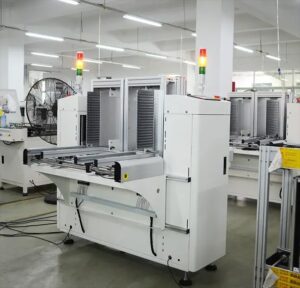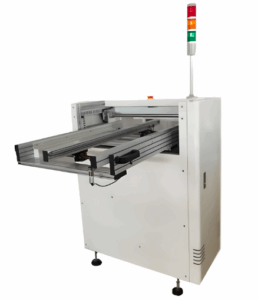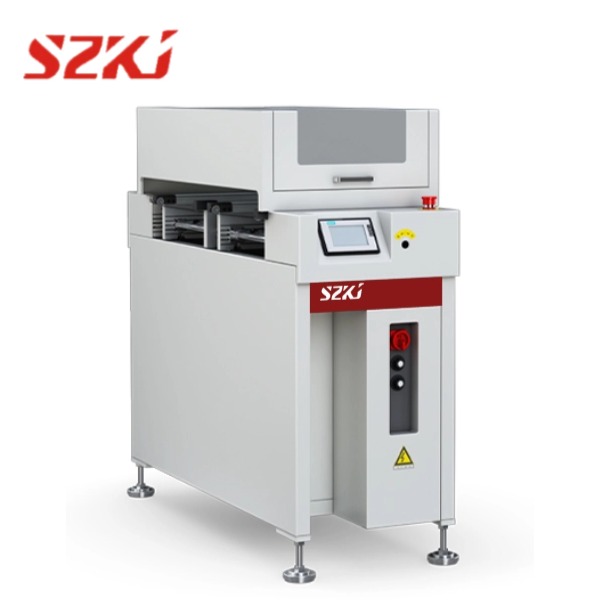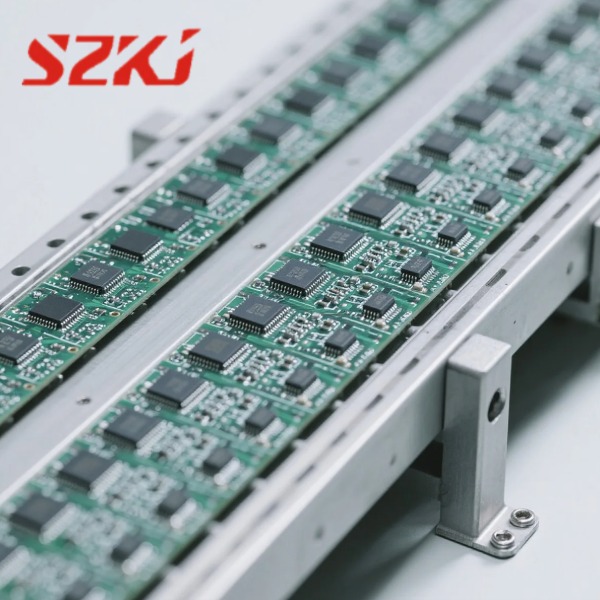Table of Contents
ToggleIn modern SMT (Surface Mount Technology) manufacturing environments, efficiency, accessibility, and production flexibility are crucial. A telescopic conveyor system addresses these needs by offering extendable transport solutions tailored for PCB handling, inspection, and line configuration adjustments. These conveyors are especially useful in SMT lines where modularity and operator access play an essential role in minimizing downtime and maximizing output.
Adaptive Conveying for Dynamic SMT Workflows
Telescopic conveyor systems use extendable structures built with overlapping frames or jointed segments, enabling operators to adjust conveyor length without disassembling any equipment. This dynamic configuration allows production lines to respond to layout changes or space constraints instantly.
In SMT environments where space is limited and human access is frequently needed for inspection or rework, telescopic conveyors provide a simple solution. Most models can extend from approximately 500 mm up to 1,200 mm, and support either manual or motorized controls for flexibility and responsiveness on the shop floor.
Enhancing PCB Movement and Process Flexibility
 Telescopic conveyor systems help manage the flow of PCBs between various manufacturing stages—such as solder pasteapplication, component placement, reflow soldering, and automated inspection. By retracting or extending sections as needed, operators can safely intervene during in-line processes to remove failed boards, pause flow for quality checks, or perform manual insertions without halting the rest of the system.
Telescopic conveyor systems help manage the flow of PCBs between various manufacturing stages—such as solder pasteapplication, component placement, reflow soldering, and automated inspection. By retracting or extending sections as needed, operators can safely intervene during in-line processes to remove failed boards, pause flow for quality checks, or perform manual insertions without halting the rest of the system.
These systems can also act as collection zones or buffers, enabling operators to temporarily hold boards before visual inspection or rerouting. In low-volume, high-variation production settings, this kind of flexibility supports lean practices and reduces line stoppages.
Integration with Line Controls and Process Timing
Telescopic conveyors integrate easily with standard SMT control systems. Their transport mechanisms are often equipped with servo or stepper motors that allow smooth acceleration and deceleration. Conveying speeds typically range from 0.6 to 18 meters per minute, with adjustments made directly through the line’s central PLC or touchscreen interface. This ensures alignment with the cycle time of upstream and downstream equipment, supporting synchronous line operation and reducing the risk of PCB collisions or jams.
Some models include features such as vacuum hold-downs, clamping arms, or guided rails to stabilize boards during transport—particularly important for lightweight or post-reflow assemblies.
Realistic Use Cases Based on SMT Environments
In actual SMT lines, telescopic conveyors are configured for multiple use cases:
Modular gap-fillers that maintain continuity between machines with variable pitch
Walkthrough gates that swing or slide to create temporary operator pathways
Integrated inspection lanes where boards can be easily extracted for manual review
Segregation conveyors for sorting out non-conforming boards during testing stages
These configurations are widely adopted in production lines where flexible layout and in-line access are critical for product variety and operator efficiency.
Practical Conveyor Types Used in PCB Assembly
 Depending on the specific process requirements, manufacturers utilize different conveyor types:
Depending on the specific process requirements, manufacturers utilize different conveyor types:
Length-adjustable conveyors that connect irregular equipment distances
Retractable gate conveyors designed for safety and minimal footprint
Clamping conveyors that secure boards for visual inspection or side processes
Low-friction transfer conveyors ideal for handling heat-sensitive or fragile PCBs
The configuration depends not only on machine spacing but also on board size, handling sensitivity, and available floor area.
Compatible Transport Equipment from the Same Manufacturer
In addition to telescopic conveyors, SMT equipment providers typically offer a family of compatible machines for conveying and handling tasks. For example, models like the FM-350W-GD Folding Aisle Conveyor, FM-220W Chain Conveyor, and FM-400W Vacuum Conveyor are commonly deployed in SMT factories.These models are tailored for integration with core SMT machinery—screen printers, chip mounters, ovens, and AOI systems—and allow manufacturers to design smooth, modular, and efficient assembly lines that support both automation and manual intervention when needed.
Conclusion: Flexibility and Functionality in One System
Telescopic conveyor systems serve a critical role in achieving agile and efficient SMT production. Their adjustable nature allows seamless operator access, in-line quality inspection, and space-saving layout configurations. When paired with supporting conveyor models and automation-ready features, they become an essential part of a responsive electronics manufacturing line.
As manufacturers prioritize uptime, line flexibility, and efficient floor use, telescopic conveyor systems offer a high-impact solution that enhances both process performance and operator ergonomics.




